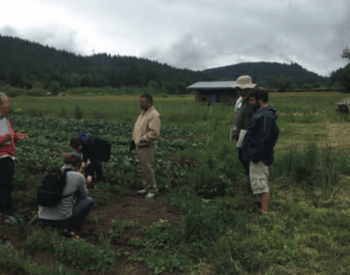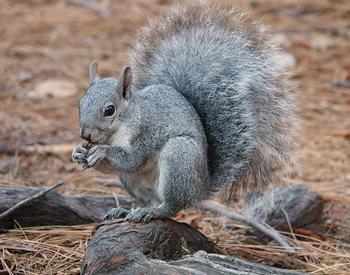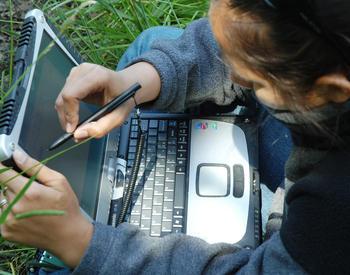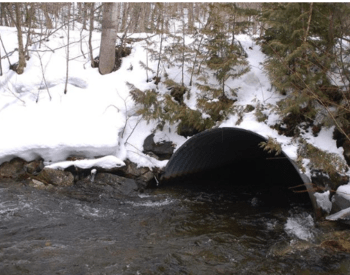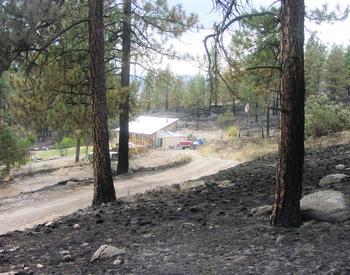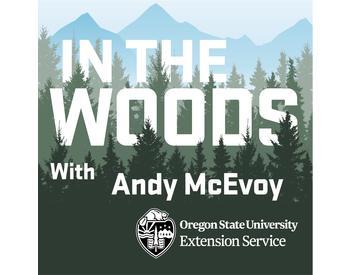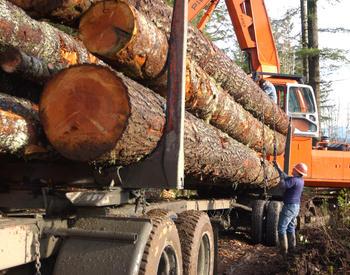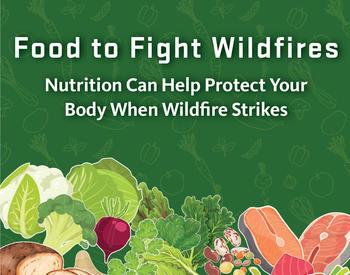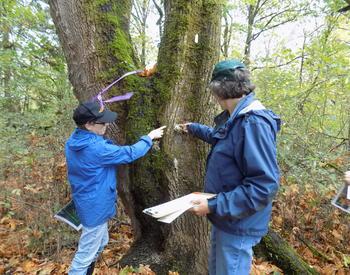Transcript
From the Oregon State University's Extension Service, you are listening to In the Woods with the Forestry and Natural Resources Program. This podcast aims to share the voices of researchers, land managers, and members of the public interested in telling the story of how woodlands provide more than just trees. They provide interconnectedness that is essential to your daily life. Stick around to discover a new topic related to forests on each episode.
All right, welcome back everyone to In the Woods Podcast, presented by the Forestry and Natural Resource Extension Program at Oregon State University. I'm Jacob Putney, extension Forester for Baker and Grant Counties in Northeast Oregon. And I'm Aaron Groth coastal Oregon Regional Fire Specialist based in Clatsop County.
And we're gonna be your host for today's episode, which is going to be a hot topic, fire weather. We are joined today by Jon Bonk and Rebecca Muessle who are both incident meteorologists with the National Weather Service in Portland. Jon, Rebecca, it's great to have you both here today. Great. Thank you for having us.
Yeah, thanks. So could you tell us a little bit about your backgrounds and what exactly an incident meteorologist is and does? Well, I, this is my second career. This is, uh, Jon, and, uh, my first career I spent about 10 years in sales and management in private business. And to realize that I wasn't happy. So I thought I'd go back to one of my childhood loves, which is, uh, either gonna be aerospace engineering or meteorology.
And really, you know, between those two, uh, meteorology can get me back to Portland. And I had a goal of working for the National Weather Service. You know, uh, in, uh, here in Portland. So, uh, I went to San Jose State University and this was back in the early 2000s. And then once graduating there, I progressed, uh, as a student intern at the Monterey office.
Then spent a couple years over at Reno and about six years, uh, up at the Pendleton office. And then, uh, since then I've been, uh, over here in the Portland office. So I've made it home. And for me, I am an Oregonian born and raised. I went to Portland State University initially and studied environmental science with a focus in sustainable forestry.
And then I went to the University of North Dakota, which doesn't seem like it would have anything to do with fire, and it does not that much. Uh, and there I studied atmospheric science. I then started my career with the weather service up in Anchorage, Alaska, and then two years later moved back down to Portland, where now I get to fulfill my dream that I've been working towards.
For the last 10 years of being an incident meteorologist, and I'm a trainee with the program, so I've only been with the program for a year thus far. Sure. So let's dive into what an incident meteorologist is. Uh, so everybody knows, a meteorologist is somebody who studies weather. And, and with that, uh, there is a volunteer faction within our federal agency that, uh, will have us go out and work directly with the incident management teams out in the field at their incident command posts.
And so what we're doing is we're out there with a, uh, providing a weather expertise, uh, with a primary focus on the safety of the firefighters and the safety of the public. Uh, so anything outside of that, whether it's strategic or tactical operations with firefighting, that's secondary. Our main mission is out there to, to protect the lives of the, the first responders, the firefighters, and uh, also the surrounding public.
Well, great. Well thank you for that. And it sounds like you both made it home, so that's great. I'm a native Oregonian myself as well. Um, so I made a joke about this episode being a hot topic, but it is the beginning of June and we all know fire season is right around the corner. So as fire season approaches, let's kind of dive deeper into fire weather.
All right. Uh, to kick us off, could you please tell us, uh, what is fire weather? And then also, uh, what are red flag warnings? Thank you. Uh, sure. Fire weather are the, the factors of weather that greatly influence, uh, the spread of wildfire. And, and precisely the three items that we're concerned about are gonna be wind, which is gonna push the fire around the, the, the hillside.
Then relative humidity, meaning how, how the dryer that it is will, will make the fuels and, and the the vegetation more readily available to burn. And then finally we have a, a little bit more esoteric element, and that's called instability or basically what is the propensity of the atmosphere to kind of act like a chimney and ventilate out, uh, any of the smoke and heat that's been generated.
And then a red flag warning. So the National Weather Service, we issue all of the warnings, watches, and advisories for the country. And a red flag warning is a warning that we issue specifically for our fire weather partners and for the public. And what a red flag means is that we are seeing wind and relative humidity conditions along with dry or cured fuels, that if those conditions were to occur and there would be a fire on the landscape, it would cause that fire to spread rapidly.
And it's the kind of the extreme growth and spread of that fire that would alarm us and put us to issue that red flag warning. Yeah, so basically we're looking at the safety aspects even in advance of an existing fire, uh, or, or the safety aspects that are going to affect an ongoing fire. Uh, yeah. You talked a little bit about what an incident meteorologist does, uh, but when an incident occurred, uh, what roles, uh, does an incident meteorologist play, uh, at the location?
And how do they fit within that incident command structure? Sure. We are most commonly placed and housed within the planning section, uh, which, you know, weather's ongoing and you think it would affect operations. But we're out there helping the, the whole planning process. So not just looking at weather for today, but weather going out a week, in some cases, weather going out a month.
Uh, so when we're in the planning section, we're, we're made available to the various sundry meetings that the incident management team has, both internally and externally. So we're helping plan, uh, give a weather prediction for the next day's plan for, uh, maybe, uh, strategic operations. So where do we, where does the incident management team want to take the fire, uh, within the next uh, seven or 10 days or the rest of their tenure.
As well as, okay, we know that this fire is going to last more than the next two weeks, uh, and move on to other teams. And so, which wanna want, we want to try and give a, a climatological vision as to when maybe, uh, some wetting rains, uh, would be more likely to occur.
So on a normal day to day, uh, what kind of like equipment or technology do you use? We have quite a few things, but you would think we actually have more than we actually do. So one of the things that is probably the most popular on a wildfire is our balloon launches. So for perspective in the in the world of meteorology, we have what's called a radiosonde, and it is a styrofoam box that's launched into the atmosphere via big balloon, and it gathers humidity data and temperature and wind speed and wind direction.
On a fire, we have a scaled down version of that radiosonde, so we will launch those on the fire as well to try and gain a little bit of perspective for the environment at the actual site. I will say that's probably the public information officer's favorite thing that happens with the incident meteorologist.
So we carry that on site with us and then we have our computer systems. We have rain gauges that will, uh, pop up in areas if we need them. And then we'll work with the fire behavior analysts on fires to put up remote automated weather sensors and measurement devices throughout the fire area. So we work in tandem with the fire behavior analysts to set up those kind of measuring systems.
So now that you mention it, could you talk a little bit about the RAWS stations? Uh, sure. These are, uh, portable weather stations, uh, that operate purely on solar power and batteries. And, uh, there are permanent stations, uh, at least in Oregon. There are, oh gosh, over 150 of them, uh, within Oregon alone. Uh, but we have the capability of ordering.
Additional portable weather stations that, uh, we can just toss in the bed of a pickup and go out and set up and, and get a lot of the same information that we'd get from these permanent stations. And again, that information is primarily fire focused, in which that they're gonna measure wind speed, temperature, humidity, uh, as well as, uh, specialized instruments that they have, uh, called a fuel stick.
And what that does is tries to give an estimate as to how much physical moisture is contained in some of the dead and down, uh, fuels on the ground. And it also, of course, would measure rain. Uh, but another instrument that it has that, that has a factor into, uh, kind of fire spread and fire behavior. And that is a pyranometer, which is an instrument that measures how much radiation is directly reaching the ground from the sun.
So a little more advanced than a kestrel? Very much so. But nowhere near as portable as a kestrel.
Um, we've all seen videos and heard about how fire can generate its own weather. Um, what can you tell us, uh, about these phenomena? Well, that's kind of where the, I would say, where the instability side of our forecasting comes into play. So when you see a fire generating its own weather, uh, generally speaking, it is burning hot.
It has a very, very rich, uh, fuel bed of heavy fuels. So like a lot of downed logs, a lot of, uh, a lot of just, I'd say just debris on the ground. Uh, so with that, once fire gets in there, it's gonna be able to generate a lot of heat, and especially on a very dry and unstable day. Again, that atmosphere is gonna act like a chimney.
So what happens is the fire on the ground creates a lot of heat, and then that heat starts to escape upward. Uh, into the atmosphere. And because of atmospheric conditions, well being what we call unstable, that vertical motion upward is just gonna get accelerated and lofted even higher and faster. And what happens then is, uh, that creates a little local void of air, a kind of a vacuum at the surface, kind of around the fire that then starts sucking in air all around it.
And with that, you start bringing more oxygen into a fire. And then more oxygen will make a fire burn hotter. And then the whole process just kind of a cycle. And what happens ultimately is, uh, in the most extreme situations, uh, you're gonna get, uh, the water vapor that's in that smoke column, uh, rise up and create a cloud.
And then if it's incredibly unstable enough, then that cloud can itself turn into a thunderstorm and, and then create a, just a vicious cycle. Of, of, uh, strong winds and lightning and it's, it's a very dangerous situation, uh, for the people on the ground, but uh, also for people, uh, in anywhere in the vicinity as that can result in very, very rapid fire spread as, as the embers get lofted up and then maybe catch a little bit of wind to go downwind, and then you're gonna start igniting fires downwind of the main fire.
So talking about that, could you tell us, uh, a little bit about your experiences and maybe what you've noticed about fire weather, uh, on some of your assignments, uh, and how maybe fire behavior changes with some changing weather patterns? Uh, well, I only have one fire under my belt, so I don't really have too much perspective, so I'm gonna let Jon tackle this one actually, because you have a lot more experience than I do.
Well, probably the what I've seen over my now 15 years of being an incident meteorologist and going out on 35 plus fires, is it, it seems like we are trending towards a lot more of this intense vertical fire behavior, uh, with, uh, a lot more, I guess, readily available fuel to burn and then just with conditions seeming to come together just right, uh, to create kind of these little fire, these, these fire storms, so to speak.
But in general, uh, I think there's just cycles that happen in various parts of the country and various parts of the continents, uh, go through their, their facets. I mean, one thing that's interesting now is we're hearing nothing about California because of all the. The rain and snow that they ended up having, uh, over the winter that clipped most of Oregon and, and maybe a little bit of southern Washington.
But, uh, much of Washington's still gonna be, uh, in a fire season this year. But we're really seeing the effects, uh, across Canada this year, especially with, uh, all the wildfires going on in, uh, Alberta and then, uh, over closer to, uh, like Ottawa and Montreal and then even, even in the coastal areas of Nova Scotia, which, which is something I don't recall hearing, at least in my 15 years of being exposed to this.
Um, one thing that is also notable, is probably how folks will go through smoke episodes and, and that is something that Rebecca can, can speak to, uh, with her experience, uh, especially describing where she was at last year. But, uh, even with our 2020 fires, we had some pretty major smoke impacts over here in the Willamette Valley.
Um, go ahead Rebecca. Yeah, so smoke, as we've kind of seen this week with folks in the Northeast, you know, smoke is a plaguing feature and on a fire it can really stifle movement and tactics for fighting that fire. So on my fire, I was on the six, um, the Six Rivers Complex down in Northern California, and every single day we were plagued that the smoke was just settling right into camp.
We had these temperature inversions setting up overnight. It would get bogged down into the valley. You see these wind shifts that you can predict every single day, but it's when it's going to lift, and I would say that the presence of the smoke and the density of the smoke is going to continue to be a problem and potentially worsen based off of the fuels that it's getting into at this point.
And I'll tell you, there's nothing like having to change an air filter on the air conditioning in your yurt three times a day because it turns black. So, yeah, it's, I've been down in that area as well. And then the six Rivers along the Klamath and Trinity River, uh, portions of Northwest California. It is, once smoke gets entrenched in there, it is very difficult to, to work its way out of there.
And, you know, one area notorious for just poor smoke conditions, um, is, is well known among firefighters and it is very much, uh, a, uh, a, uh, dreaded place to go. Once, uh, once you, you know, that, uh, your fire camp's gonna be based there. My brother worked in Northern California for a number of years and spent a lot of time in Six Rivers around that area.
So, so, um, within the National Weather Service and our National Oceanic and Atmospheric Administration and your roles as meteorologists and, um, incident meteorologists, incident meteorologist trainee, what do you, what would you like our listeners to know? What would you like the public to know? Well, as I said, as an incident meteorologist, it's a volunteer cadre, meaning we're doing this on top of our actual position descriptions.
Uh, and for, for us, that is forecasting your, your day-to-day weather, watching out for hazard, winter hazards for summer hazards, heat hazards, uh, wind thunderstorms. Pretty rarely around here, but still tornadoes. Uh, fortunately we are, our ocean waters are cold enough. We don't deal much directly with hurricanes, but, but we will get, uh, some hurricane remnants that come by and can bring a lot of rain, uh, flooding concerns.
So it's our, our day-to-day job has us forecasting literally everything every day, 24 hours a day, seven days a week. So, so we're on a rotating shift. So one of the, uh, one of the blessings I see of, of unfortunately being, taken away from your families for up to two weeks at a time with, you know, maybe 12 hours notice, is that you get to have a routine schedule.
You get to have a normal, it's like, okay, I'm gonna be awake and on shift at 6:00 AM or at 5:00 AM so that I can give a 6:00 AM briefing and I know that I'm gonna be going to sleep or at least going off shift at about 10 o'clock at night. And so that's, that's one kind of side benefit that you, you do get to have a regular schedule.
Ordinarily we're working rotating shifts. Uh, so we may have three day shifts followed by four, uh, overnight shifts, and then take some, take two or three days off, and then we'll get, uh, evening shifts and back to day shifts and. And I don't know if, is there anything you wanna add with that? I mean, I just got off of work and it's 7:00 AM so I mean, that's, that's it.
But I think the big thing with the weather service and with uh, NOAA, is that we have a mission of protecting life property. And the enhancement of the US economy. And as incident meteorologists, we're out in the field and we're doing just that. It's not only the safety of the people, but it's the safety of the environment, the people working on the fires, and we're helping the team achieve their mission.
So we have our own mission and we're assisting them to achieve theirs. It is not the easiest job in the world. I think a lot of people, including my friends and family, they think it is so cool that I get to go out to wildfires. And let me tell you, it is, it is really cool, but there's a lot of high stress in it.
We go through a lot of training and we're, we're trained in this specialty, but when you have an incident commander or the operations chief running into your yurt saying, "Hey, we have a spot in so-and-so location. I need a forecast in five minutes." You just have to go. And I don't think anything really prepares you for that other than just doing it.
Right. Uh, building on that is, uh, being an incident meteorologist is by far the most rewarding thing that I've done with my, with my weather service career. Uh, yes. When we're in the office, we can look at instruments, we can watch the news, we can see the impact of our forecast, but the nothing, absolutely nothing compares to being out there in the field, working with these teams and going out and directly observing the impact of your forecast and seeing how, how a fire that might just be smoldering along or, or just kind of very, I guess, minor fire behavior, uh, can suddenly hit a change of terrain, change of fuels and a change of weather.
To then just suddenly become very active and, and being able to, uh, at least have some facet of predicting which hour of the day that's going to happen.
Uh, is is pretty darn amazing. So building off of that, when say a red flag warning is issued, uh, what would you like folks to do or what should they know or what should they be aware of, um, when that happens? Uh, so the first thing that I tell people, and it's kind of the thing I hammer home a red flag warning does not mean that a fire is going to start.
It is specifically that the weather conditions are suitable, that if a fire were to start or there is one on the landscape, that it could spread rapidly. So, there's sometimes a lot of confusion. They think, oh, there's a red flag warning. That means there's going to be wildfires today, and that's just not the case.
I really encourage people all summer long, but especially as we near kind of the peak of what is traditionally our fire season to be prepared. You never know when that lightning strike is going to happen and maybe it spreads quickly and you don't wanna be caught off guard. So, not just when a red flag warning is issued, but anytime during the summer, have your emergency preparedness kit ready to go so that you can evacuate quickly if you get that go now, signal from your emergency managers.
Make sure that you've prepared your home and it you've made a defensible space around your home. Or moving the burnable fuels and objects from the nearby to your home. Um, practice safe. I don't know, existing, I don't know if that's a great word, but things like, don't park in the dry grass.
Don't carry chains behind your car, extinguish your fire, your fires completely. You know, do activities that are going to be safe and minimize your potential for creating a spark. So anytime there's a red flag warning, that means we see the potential for rapid fire evolution and we need the public to help us keep those fires from happening in the first place.
A majority of fires are started by non-natural causes, so by humans. And so it's our responsibility to not only alert that, hey, there's weather concerns, but also now is the time that people need to be safe in their actions. I think that was well said, taken those extra steps to be careful during those conditions.
Well, um, we're kind of nearing the end here, but I wanna make sure we don't miss anything. Um, do you have any parting thoughts on fire weather, extreme weather events or, uh, especially resources where folks can go to learn more or get these notifications about things like red flag warnings? Sure. If we can inspire any kids to get into the field of meteorology.
I am, I am the textbook example of don't be afraid of the math. I am horrible with math. I get ridiculous test anxiety. Same. And uh, and it kept me away from what has proven to be an incredibly rewarding career for about 10 years. So, uh, first of all, don't be afraid of the math. If you're interested in studying meteorology and wanna make it a career, if you're, if you're already fascinated with whether, why not make your career your hobby?
Uh, exact, and that's kind of where I ended up, ended up landing here. So, uh, a great place though. Just right now, if you wanna learn more about the weather and not take a, take all the, the college classes and all that is, there's an online resource, uh, that's produced by the National Weather Service, and that is called the Jet Stream Online Weather School.
So I'd say just if you take, take your favorite search engine and uh, type in "JetStream", all one word, and then online. And then weather, it's probably gonna show up as that top result. And it is just a self-paced module of a bunch of web pages. Uh, that, uh, will take you through a very basic, uh, and, and not, not, they dive into some, some, some sharp topics too.
But, uh, but again, a good understanding of weather and, and, uh, maybe a new appreciation of why the clouds look like they do. And I encourage people to visit our website all the time. It's www.weather.gov/portland in our case, but you can just do weather.gov and you will see every single watch warning advisory for the entire country.
For our local area, you can click on it, learn more. You've got local forecasters here that are diving into the local terrain and the features, and so we're forecasting on a much smaller scale for the public. So our website has probably just about any weather feature you have a question about. We're forecasting for it.
Even things that people wouldn't think we're forecasting for. So our website is, is the number one place to go for warnings, but then your local communities often will have voluntary alerts that you can sign up for, um, through your emergency management departments. And it can be via email, phone call, text message.
Um, those are some really easy resources and free resources that are available to you to get your weather nerd on. Yep. And if you really want to dive deep into fire weather specifically, there are, uh, there's a, a program, a cooperative, or a cooperative institute for meteorological studies, something like that.
I can't remember. University cooperation, atmospheric, atmospheric research, something ucar, we call it Ucar. Yeah, there's, yeah, a whole bunch of various modules. Uh, but a, a couple of the specific uh, classes that we're teaching firefighters about the weather, one of them is available online, and that is, uh, it's called S 290, so Sam basically s as in Sam, 290.
And, uh, that is, uh, intermediate wildland fire behavior, but a big portion of that is, is fire weather specifically. And so it can, it can really take the deep, nerdy dive, uh, if you want to get into, uh, what we're looking at on a daily basis. Okay, weather plays a critical role when it comes to fire and fire behavior.
Careful monitoring and prediction are critical for suppression efforts, firefighter safety, and avoiding disaster. Jon, Rebecca, thank you so much for sharing your expertise with us today. Uh, if any questions came up while you were listening today or you'd like to learn more, uh, please send us a comment or a message on our website.
Yeah, thank you Jon and Rebecca so much for joining us today. Um, but before we wrap up, we like to do what we call our lightning round. That's how we conclude each episode. So we're gonna ask each of you a few questions. So Jon, let's start with you first. And the first question is, what is your favorite tree?
I gotta say my favorite tree used to be the Ponderosa pine. And I just love the long needles and, and the giant cones and such. But then I was on a, on a wildfire down in Sequoia National Park and Sequoia National Forest, and I gotta say those giant sequoias, uh, really grabbed, grabbed my heart. They're not the tallest trees in the world, but boy are they the most massive.
Uh, and I, I also love the, the strong contrast between the huge size of those trees, but then the little teeny cones that they produce, you know, it's just, uh, that's my favorite tree now. That is a good one, but I am still partial to the Ponderosa pine here in northeast Oregon. All right. The next question is, what is the most interesting thing you bring with you in the field?
Uh, well, one thing that you would think of as a meteorologist, I wouldn't need this, but, uh, just like all the other firefighters are out on the line. I'm carrying a fire shelter. And, uh, just, it's a, it's a line of defense that should everything go wrong that day, uh, that, and I find myself in a situation where I cannot, uh, comfortably escape a wildfire, then I will pull out that fire shelter.
And we, we are trained every year and we refresh every year to, to use that fire shelter and, and how to get in it. And, And, uh, at least give ourselves the best chance of survival. So, uh, again, not something you'd expect a meteorologist would necessarily need out on the field, but because we go out there and we're, we're learning the train and really trying to embed, uh, with the fuels and, and the firefighters as much as we can.
Yeah, that's probably an interesting thing that, that folks would be surprised to hear that we carry. Yeah, I think it's a really important thing to have, especially on an incident. Um, and then lastly, what resources would you recommend for our listeners? We kind of went through a lot of them already, but if you have any others to add. And then we'll move on and see what Rebecca's. Well, there's, there's a lot of good podcasts out there if you just wanna stay current on, on what's going on around the country.
But probably another good resource that is authoritative is gonna be our, uh, Northwest Interagency Coordination Center. And, uh, probably a, a good way to either look is for that term or, uh, NWCC fire. Would be a good search term just to, to get to their website. And that's, that's the, the, uh, group of, of federal and state partners that, uh, run a center for the movement of resources across the region.
So, say, we know that, uh, that, uh, Southwest Oregon is not having a strong need for fire equipment and, and, and crews and such. Uh, but say Northeast Washington does have a need. They're the group that helps coordinate the movement of those, of those firefighting resources from southwest Oregon over to northeast Washington or vice versa.
So, uh, there's a, a, an entire group of folks that are dedicated towards assessing fire danger over there, especially on a regional basis. So that's another good regional resource. Okay, great. Well, thank you Jon. All right, Rebecca, your turn. First question was, what is your favorite tree? Okay, so this morning I was thinking about what my favorite tree was, and I realized that my favorite tree is actually a bush.
Uh, it's the Oregon grape. So I don't know if that counts. So then I did, I got on, um, online and I did some searching. So I'm a very big, like native Oregon, native Pacific Northwest vegetation person. So I do like the Oregon white oak. It makes some pretty good wine barrels and I like to, uh, have the safe campfires in the summer with it.
So I think that's my second favorite that's actually a tree, not a bush. No, I think those are both great. So we, we'll allow it. Oregon White Oak is a great one. Um, so, and then what is the most interesting thing you bring with you in the field? So, mine is not nearly as technical as Jon's, uh, I, I bring Pop-Tarts with me out into the field.
I sometimes need a break from the very awesome but filling protein packed food that they give you. And sometimes you just need a little bit of trash food. So, uh, Pop-Tarts, that's my interesting thing. Pop-Tarts are a guilty pleasure. What flavor? Ooh, either strawberry or blueberry. Yeah, both good choices. I do like the brown sugar and cinnamon ones too.
All right. And then I know we've already listed a bunch of them here, but if there's any other resources you want to add, or, uh, any info for folks that might be interested in learning more about fire, weather or meteorology? Incident meteorology? Oh man. I feel like we've covered so much, but yeah. You have another idea?
I'm gonna, I'm gonna hop on cause I just thought of that. That's gonna be nc web.org. Again, an official source for fire information. You know, yes facebook and the rest of social media and, and such can, you can get information there, but it's all secondhand and really the the best place to go is NC Web uh, dot, oh it's not nc web.org anymore though.
If you just search NC Web, it will come up and I will tell you, you will get lost. Not in, 'cause it's confusing in that you will get yourself into a rabbit hole that you cannot get yourself out of because they will post pictures from the fire and how it's growing and every single day, maps, maps.
And then also if you have a fire either in your community or maybe there's one going on that you're interested about and wanting to learn more. Most of the fire teams now have a really strong online presence where they live stream their briefings and things like that. And so it, and usually on Facebook, so you can find maybe the fire that you're interested in and you can actually watch the briefings and learn more from what's going on for, from the people actually in the field.
No, we'll certainly, uh, make sure we get all these links that, uh, of the resources you mentioned on our website too, so folks can follow those and maybe go down a rabbit hole it sounds like.
Well, um, before we conclude, are there any questions that you have for Jake and I? What is something new you learned today about incident meteorology that you did not know before?
In talking to you, I have a far better idea of how incident meteorologists are part of the team and what area in which they would work, and then also how your expertise would be drawn upon by multiple section chiefs of an incident management team.
Yeah, I would echo that as well, and also that you mentioned that it's on top of your regular position duties. Wow.
Yeah, so when we get called out to the fires, again, it's usually with very short notice, but being students of fire that we are, we kinda have an idea that's like, oh, we may be getting a call soon.
Um, but, uh, yeah, so not only are, are, are our lives disrupted. Our family's lives are disrupted again for generally up to two weeks, uh, with very short notice. But then also the lives of our, our folks remaining back in the office are disrupted. So a lot of those folks really step up and, and cover the shifts that we were originally scheduled for.
And they, they could pick up some overtime as well. And uh, that's pretty amazing. They're working doubles. They're working midnight shifts to day shifts. They're working 10:00 PM to 3:00 PM and yeah, they really step up to support us and we, we all have a unified mission. Yeah. And we certainly couldn't do this without the support of our families and especially the support of our folks back that stay back in the office.
Uh, thank you again so much for being here today, Jon and Rebecca. Um, I think we learned a ton and you gave us a lot of things to think about and resources to draw upon as the fire season nears. Well, thank you, Aaron. Thank you, uh, Jacob for, for having us. Appreciate it. Yeah, no, absolutely. I think I'll have a different perspective and, uh, really have a different idea what's going on out there when I'm either out in the field or on an incident this summer.
And I echo what Aaron said. Yeah. Thank you both so much. Um, well, this concludes another episode of In the Woods. Thank you all so much for listening. Uh, don't forget to subscribe and we will see you all next time. Bye everyone.
Thank you so much for listening. Show notes with links mentioned on each episode are available on our website inthewoodspodcast.com. We would love to hear from you, visit the tell us what you think tab on our website to leave us a comment, suggest just a guest or topic, or ask a question that can be featured in a future episode. And, also, give us your feedback by filling out our survey.
In the Woods was created by Lauren Grand, Jacob Putney, Carrie Berger, Jason O'Brien and Stephen Fitzgerald, who are all members of the Oregon State University Forestry and Natural Resources Extension team. Episodes are edited and produced by Kellan Soriano. Music for In the Woods was composed by Jeffrey Hino and graphic design was created by Christina Friehauf.
We hope you enjoyed the episode and we can't wait to talk to you again next month, until then what's in your woods?
In this episode, Jacob Putney and Aaron Groth invite Jon Bonk & Rebecca Muessle on the show to discuss the role incident meteorologists play in fighting wildfires. Both Bonk and Muessle are incident meteorologists for the National Weather Service in Portland, Oregon.
